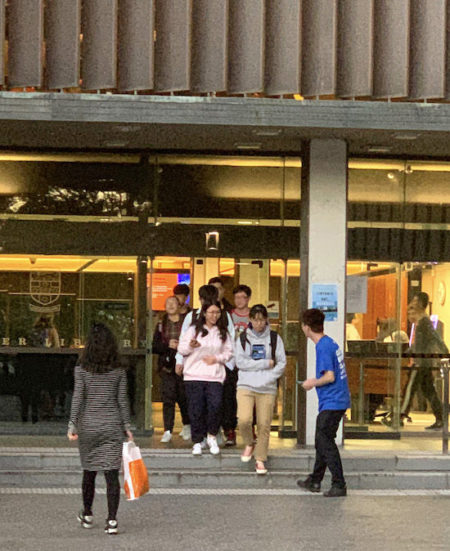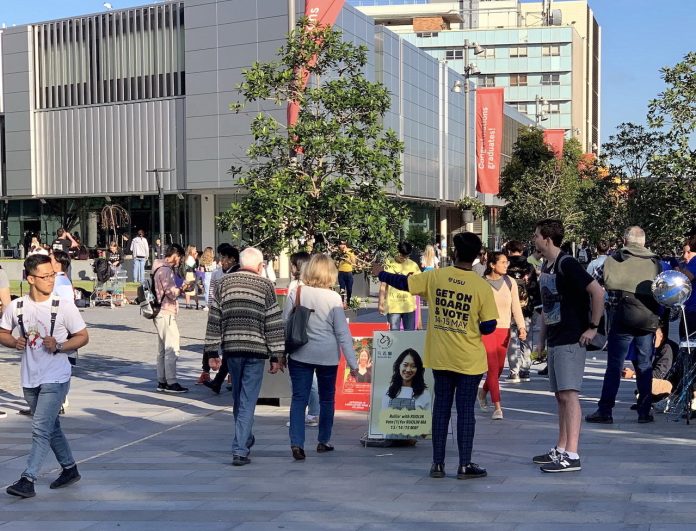By the time this year’s University of Sydney Union (USU) Board election had come to an end, student publication Honi Soit reported 6454 votes had been cast, which was a record number, “almost double the turnouts of 2018 and 2017”.
But while this should have delighted both the USU and its candidates, all I could think about was the indifference of students to the voting process.
Let’s look at the voting rate first. According to the University’s 2018 annual report, it had 61,309 enrolled students in total, including 22,144 international students. As those are the latest enrolment statistics publicly available, I will use them for calculation’s sake.
That makes the voting rate 6,454/61,309≈10.5 per cent.
What? 10.5 per cent! That’s pretty low in a country with compulsory electoral voting. Can we really be happy to see such a poor turnout? Only 105 out of every 1000 students bothered to vote. So where were all the other students during the three days of voting?
The campaigners who canvassed for candidates said it was hard for them to persuade others to vote. Helaina Beltrame, a campaign team member for candidate Nick Forbutt, said: “Lots of people just don’t care.” She approached 30 people in two hours on the final voting afternoon of May 15, and only four people said they had voted or would vote.
Skylor Duan, a freshman doing Business Information Systems, canvassing for candidate Oscar Bai in Eastern Avenue from 11 am to 3 pm, and said no more than 20 people indicated a voting intention.
“It’s very low participation,” said campaigner Alexander McManis, supporting candidate Ellie Stephenson. As a senior student doing International Relations, this is the third time he has joined a USU election campaign.
He also stayed in Easter Avenue for a couple of hours, only to “get around 12 people to the line”.
“Lots of people don’t like student politics and they find the campaign annoying,” he said. “They’ve got places to go and people to see. They don’t want to spend time on voting.”
Some students were deliberately rude to campaigners just because they were approached for a few seconds while walking. Jamilla Dempsey, a campaigner doing walks and talks, had people swear at her and many other campaigners had to bear nasty remarks. Now, if indifference brings about malice, you have to wonder where the indifference comes from.
Dempsey said she felt discouraged by the participation rate. “The election is significant for our uni. The USU has so much money in its budget but students are just choosing to let random people do what they want with that money. That is scary.”

After the election, I had dinner with five classmates. Among the six people who were studying at the university, only two had voted. I asked the other four why they didn’t vote, and they said they didn’t know about the USU election or the candidates.
And here’s the problem. It’s understandable that if you don’t know any of the candidates you might not want to vote randomly. But if people didn’t know the election was on, then that’s a major problem of information delivery.
Yet from candidate registration to election results, the entire process of the USU Board election lasted only six weeks, barely enough time for people to register it was happening.
Candidates nominated at the end of March. In early April, the USU convened a meeting of candidates to inform them of the election rules. In the second half of April, two newspapers on campus interviewed and reported on the candidates. In the first week of May, a Soapbox Q&A session was held where candidates and students met. On May 13-14 there was pre-polling. On May 15, Election Day: the vote ended at 6:30 pm and the final result came out that night.
Zizheng (Oscar) Bai, who was elected to the USU Board, said that the university and the USU both have detailed regulations for all aspects of candidate campaigning.
The pre-election campaign lasted only a week. The online campaign started the Saturday of the week prior to Election Day and the face-to-face campaign started that Monday. Candidates are forbidden to run campaign events in advance.
It is difficult to reach 60,000 students within a week, even when the university sends emails to everyone. The uni did send two messages about the USU election, one about the Soapbox and another about Election Day. However, because this information was compiled into a newsletter with other items, and placed in inconspicuous positions, many students may not have seen these messages. It’s likely many people didn’t realise the election was on until they saw campaigners walking up and down campus trying to attract attention.
The low voter turnout also suggests students know little about the USU. Many students know the USU has something to do with the Access card and discounted meals on campus. That’s it. But they may not know that USU is a student organisation that manages more than 100 clubs and societies, more than ten university restaurants, supermarkets and souvenir stores, and earns more than AU$28 million annually.
Ultimately, there is too little publicity about what the USU does on campus. The USU does publish Pulp, but it’s unclear how many students actually read it and understand its relationship to the union. That is why some students don’t understand how USU elections will affect them and may not see the changes their vote could make.
The low participation could also be related to a lack of community feeling on campus. Before she attended USyd Jamilla Dempsey went to the Australian National University (ANU) in Canberra, which she said has a much stronger sense of community and more discussion about student issues.
“[At USyd] we don’t have many community spaces where all students can come. We don’t interact online as much,” she said. “In ANU, when there was an election everyone would start posting about it on student groups and everyone would discuss things, and in that way everyone learned about the election and how important it was. We don’t have the same things here”.
So, if we want to improve students participation in the next USU election, we first need to see more and more prominent publicity about what the USU does, more transparency about its activities and finances, and more online debate about how it works.
The university could also do more to inform students about the role of the USU, and about why the election of student candidates is important.
Only in these ways, can we reduce the ignorance about the USU’s critical role on campus and the embarrassment people might feel when they are asked to vote for people they don’t know when an election is upon us.


